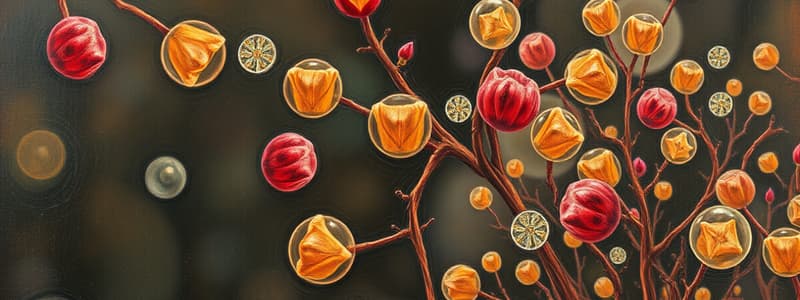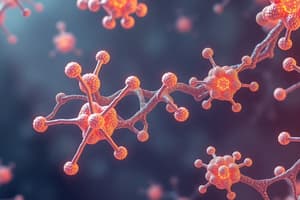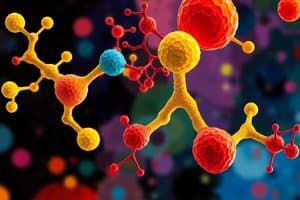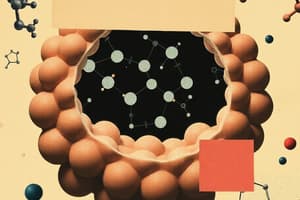Podcast
Questions and Answers
What is the primary role of organelles within a cell?
What is the primary role of organelles within a cell?
- They act as storage for cellular waste.
- They provide structural support to the cell.
- They regulate the movement of molecules across the cell membrane.
- They perform specialized functions that are essential for cell operation. (correct)
Which statement accurately describes the charges inside and outside the plasma membrane (PM)?
Which statement accurately describes the charges inside and outside the plasma membrane (PM)?
- The inside of the PM is positively charged due to proteins.
- The outside of the PM is positively charged due to sodium ions. (correct)
- The outside of the PM is negatively charged due to sodium ions.
- The inside of the PM is neutral due to balanced ion concentrations.
What is the liquid portion inside of the cell commonly referred to as?
What is the liquid portion inside of the cell commonly referred to as?
- Cytoplasm
- Interstitium
- Nucleus
- Cytosol (correct)
What is the primary function of the mitochondria in a cell?
What is the primary function of the mitochondria in a cell?
Which of the following compartments is specialized for chemical reactions?
Which of the following compartments is specialized for chemical reactions?
In which type of cell is the cell wall found?
In which type of cell is the cell wall found?
What does compartmentalization in cells refer to?
What does compartmentalization in cells refer to?
What is interstitial fluid?
What is interstitial fluid?
What is the significance of sodium ions in relation to the cell membrane's charge?
What is the significance of sodium ions in relation to the cell membrane's charge?
Which macromolecule is primarily involved in forming cell membranes?
Which macromolecule is primarily involved in forming cell membranes?
What is the primary function of the sodium-potassium pump?
What is the primary function of the sodium-potassium pump?
Which process is primarily involved in the movement of water through the cell membrane?
Which process is primarily involved in the movement of water through the cell membrane?
What role does ATP play in the function of pumps like the sodium-potassium pump?
What role does ATP play in the function of pumps like the sodium-potassium pump?
What is the significance of concentration gradients in cellular transport?
What is the significance of concentration gradients in cellular transport?
What type of transport does the term ‘antiport’ refer to?
What type of transport does the term ‘antiport’ refer to?
What molecule serves as a carrier in the sodium-potassium pump mechanism?
What molecule serves as a carrier in the sodium-potassium pump mechanism?
What is the effect of lower concentration on the movement of particles across membranes?
What is the effect of lower concentration on the movement of particles across membranes?
What is one potential consequence of malfunctioning ion pumps in cells?
What is one potential consequence of malfunctioning ion pumps in cells?
Which of the following statements about the potassium pump is correct?
Which of the following statements about the potassium pump is correct?
Which of the following ions is primarily transported out of the cell by the sodium-potassium pump?
Which of the following ions is primarily transported out of the cell by the sodium-potassium pump?
What is the role of organelles in relation to cellular compartmentalization?
What is the role of organelles in relation to cellular compartmentalization?
Which structure is primarily responsible for regulating the movement of particles into and out of a cell?
Which structure is primarily responsible for regulating the movement of particles into and out of a cell?
In terms of charges inside and outside of the plasma membrane, what is true?
In terms of charges inside and outside of the plasma membrane, what is true?
Which macromolecule type is crucial in forming cellular structures and interacting with other macromolecules?
Which macromolecule type is crucial in forming cellular structures and interacting with other macromolecules?
What effect does compartmentalization have on cellular functions?
What effect does compartmentalization have on cellular functions?
What term refers to the liquid portion of the blood that contains water, proteins, and electrolytes?
What term refers to the liquid portion of the blood that contains water, proteins, and electrolytes?
What is the consequence of sodium ions having a higher concentration outside the cell?
What is the consequence of sodium ions having a higher concentration outside the cell?
Which statement accurately describes the internal environment of the cell?
Which statement accurately describes the internal environment of the cell?
What is required for the sodium-potassium pump to function effectively?
What is required for the sodium-potassium pump to function effectively?
Which statement accurately describes the mechanism of the sodium-potassium pump?
Which statement accurately describes the mechanism of the sodium-potassium pump?
What is the primary consequence of a malfunction in the sodium-potassium pump?
What is the primary consequence of a malfunction in the sodium-potassium pump?
Which type of transport mechanism does the sodium-potassium pump exemplify?
Which type of transport mechanism does the sodium-potassium pump exemplify?
What role do neurotransmitters play in relation to cellular transport?
What role do neurotransmitters play in relation to cellular transport?
What is the effect of a lower concentration gradient on particle movement across a membrane?
What is the effect of a lower concentration gradient on particle movement across a membrane?
Which component primarily provides energy for the functioning of ion pumps like the sodium-potassium pump?
Which component primarily provides energy for the functioning of ion pumps like the sodium-potassium pump?
What is the primary role of the sodium pump in cells?
What is the primary role of the sodium pump in cells?
How does the potassium pump function relative to the sodium pump?
How does the potassium pump function relative to the sodium pump?
In what process are neurotransmitters involved in cellular transport?
In what process are neurotransmitters involved in cellular transport?
Which of the following structures is vital for the compartmentalization of cellular functions?
Which of the following structures is vital for the compartmentalization of cellular functions?
What is required for proper functioning of the sodium-potassium pump?
What is required for proper functioning of the sodium-potassium pump?
What is the primary reason for the negative charge inside the plasma membrane?
What is the primary reason for the negative charge inside the plasma membrane?
What effect does a malfunctioning sodium-potassium pump have on cellular function?
What effect does a malfunctioning sodium-potassium pump have on cellular function?
What term refers to the liquid surrounding the red blood cells within blood vessels?
What term refers to the liquid surrounding the red blood cells within blood vessels?
Which of the following roles does the mitochondria primarily serve in a cell?
Which of the following roles does the mitochondria primarily serve in a cell?
Which feature is most characteristic of the cytosol within the cell?
Which feature is most characteristic of the cytosol within the cell?
Flashcards are hidden until you start studying
Study Notes
Types of Macromolecules
- Four main types of macromolecules interact to form cells.
- Macromolecules include proteins, lipids, carbohydrates, and nucleic acids, which play diverse roles in cellular functions.
Cellular Functions
- Cells perform various jobs, including facilitating chemical reactions.
- Cellular transport involves the movement of particles in and out of cells.
- Compartmentalization allows organelles to specialize and carry out distinct functions.
Cell Structure
- The cell wall is present only in plant cells, providing structural support.
- Cytosol refers to the liquid portion of the cytoplasm, primarily composed of water.
- Nucleus is the largest organelle and serves as the control center of the cell.
- Mitochondria are crucial for energy production, often termed the "powerhouse" of the cell.
Membrane Potential
- The outside of the plasma membrane (PM) carries a positive charge due to an excess of sodium (Na) ions.
- The inside of the PM is negatively charged due to proteins, with nearly all proteins having a negative charge.
Blood Components
- Plasma is the liquid portion of blood found in blood vessels.
- Interstitial fluid refers to the fluid surrounding cells outside of red blood cells (RBCs) within the circulatory system.
Sodium-Potassium Pump
- The sodium-potassium pump moves sodium (Na) and potassium (K) ions against their concentration gradients, essential for maintaining cell membrane potential.
Water Movement
- The movement of water (H2O) is critical to various bodily systems, including the urinary system.
Protein Functions
- ATP (adenosine triphosphate) and ADP (adenosine diphosphate) play significant roles in cellular energy transfer.
- A class of proteins, such as myosin, is involved in various cellular processes, including muscle contraction.
Transport Mechanisms
- Intracellular transport mechanisms ensure the movement of substances within the cell, while external transport mechanisms control the movement of molecules into and out of the cell.
Neurotransmitters
- Neurotransmitters are synthesized in cells and play vital roles in communication between neurons.
Types of Macromolecules
- Four main types of macromolecules interact to form cells.
- Macromolecules include proteins, lipids, carbohydrates, and nucleic acids, which play diverse roles in cellular functions.
Cellular Functions
- Cells perform various jobs, including facilitating chemical reactions.
- Cellular transport involves the movement of particles in and out of cells.
- Compartmentalization allows organelles to specialize and carry out distinct functions.
Cell Structure
- The cell wall is present only in plant cells, providing structural support.
- Cytosol refers to the liquid portion of the cytoplasm, primarily composed of water.
- Nucleus is the largest organelle and serves as the control center of the cell.
- Mitochondria are crucial for energy production, often termed the "powerhouse" of the cell.
Membrane Potential
- The outside of the plasma membrane (PM) carries a positive charge due to an excess of sodium (Na) ions.
- The inside of the PM is negatively charged due to proteins, with nearly all proteins having a negative charge.
Blood Components
- Plasma is the liquid portion of blood found in blood vessels.
- Interstitial fluid refers to the fluid surrounding cells outside of red blood cells (RBCs) within the circulatory system.
Sodium-Potassium Pump
- The sodium-potassium pump moves sodium (Na) and potassium (K) ions against their concentration gradients, essential for maintaining cell membrane potential.
Water Movement
- The movement of water (H2O) is critical to various bodily systems, including the urinary system.
Protein Functions
- ATP (adenosine triphosphate) and ADP (adenosine diphosphate) play significant roles in cellular energy transfer.
- A class of proteins, such as myosin, is involved in various cellular processes, including muscle contraction.
Transport Mechanisms
- Intracellular transport mechanisms ensure the movement of substances within the cell, while external transport mechanisms control the movement of molecules into and out of the cell.
Neurotransmitters
- Neurotransmitters are synthesized in cells and play vital roles in communication between neurons.
Types of Macromolecules
- Four main types of macromolecules interact to form cells.
- Macromolecules include proteins, lipids, carbohydrates, and nucleic acids, which play diverse roles in cellular functions.
Cellular Functions
- Cells perform various jobs, including facilitating chemical reactions.
- Cellular transport involves the movement of particles in and out of cells.
- Compartmentalization allows organelles to specialize and carry out distinct functions.
Cell Structure
- The cell wall is present only in plant cells, providing structural support.
- Cytosol refers to the liquid portion of the cytoplasm, primarily composed of water.
- Nucleus is the largest organelle and serves as the control center of the cell.
- Mitochondria are crucial for energy production, often termed the "powerhouse" of the cell.
Membrane Potential
- The outside of the plasma membrane (PM) carries a positive charge due to an excess of sodium (Na) ions.
- The inside of the PM is negatively charged due to proteins, with nearly all proteins having a negative charge.
Blood Components
- Plasma is the liquid portion of blood found in blood vessels.
- Interstitial fluid refers to the fluid surrounding cells outside of red blood cells (RBCs) within the circulatory system.
Sodium-Potassium Pump
- The sodium-potassium pump moves sodium (Na) and potassium (K) ions against their concentration gradients, essential for maintaining cell membrane potential.
Water Movement
- The movement of water (H2O) is critical to various bodily systems, including the urinary system.
Protein Functions
- ATP (adenosine triphosphate) and ADP (adenosine diphosphate) play significant roles in cellular energy transfer.
- A class of proteins, such as myosin, is involved in various cellular processes, including muscle contraction.
Transport Mechanisms
- Intracellular transport mechanisms ensure the movement of substances within the cell, while external transport mechanisms control the movement of molecules into and out of the cell.
Neurotransmitters
- Neurotransmitters are synthesized in cells and play vital roles in communication between neurons.
Studying That Suits You
Use AI to generate personalized quizzes and flashcards to suit your learning preferences.



